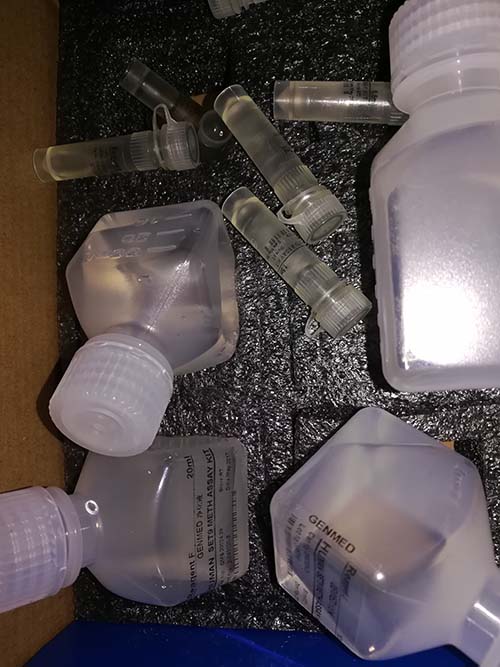Soybean endogenous gene nucleic acid detection kit (one-tube PCR-fluorescent probe method SN standard)
â—† Product Description
The transgenic detection series can amplify specific nucleic acid fragments of transgenic components in food, feed and other samples, and judge the results by real-time amplification curve. This product is used for the detection of soybeans with a detection limit of 0.1% .
â—† Product composition (48 test)
043012M I | |
Reagent | content |
A-Lectin-P | 20μL × 8 tubes × 6 rows |
NG-P | 100μL × 1 |
PG-Lectin-P | 100μL × 1 |
â—† Applicable instruments
A PCR instrument such as a fluorescent PCR machine (ABI 7500, CFX 96, Mx 3005P, LineGene 9600).
â—† Self-supplied supplies and instruments
1 sterilize 1.5mL or 2.0mL centrifuge tube; 2 sterilize 0.2mL PCR tube or octa tube; 3 ice box; 4 pipette (11-10μL, 10-100μL, 100-1000μL) and matching sterilization tips 5 centrifuge; 6 vortex mixer; 7 metal bath; 8 homogenizer, mixer or mortar and other grinding equipment; 9 electronic balance.
â—† Notes
1. This reagent has high detection sensitivity. In order to prevent pollution, the experiment is to be partitioned.
1) First zone: reagent preparation zone.
2) Second zone: sample preparation area.
3) Zone 3: Amplification and product analysis zone.
★ It is best to physically isolate the partitions to avoid contamination caused by human factors.
2. Wear work clothes and latex gloves during the experiment, use pipettes, and treat all waste generated in the test in time.
3. Strictly follow the operation steps, reagent preparation and sample loading steps should be carried out on ice in strict accordance with the instructions.
4. The components in the reaction solution are sensitive to light and should be stored away from light. The reagent should be completely thawed before use, but repeated freezing and thawing should be avoided. It is recommended to centrifuge for 30 seconds before use, and store the reaction solution in an appropriate volume according to the frequency of detection.
5. After the reaction is completed, the expansion tube should be placed in a sealed bag and discarded. On the same day, the lid is opened and the aerosol is easily contaminated. It is forbidden to open the lid.
6. Do not mix and use different batches of reagents and use them within the validity period.
â—† Sample processing
Samples prepared by the method of GB/T 19495.3-2004 Detecting and Purifying Nucleic Acids for Genetically Modified Products or other standards are used for sample preparation.
For detailed steps, please follow the standard operation or check the food safety software.
â—† Experimental operation
The reagents were completely thawed and the components were centrifuged for 30 s.
1. Reagent preparation (reagent preparation area, placed in an ice box):
If there are N samples to be tested, refer to the table below, calculate the amount of reaction solution according to N+2 (N samples to be tested + 1 negative control + 1 positive control), vortex and mix, centrifuge for 30s, divide Installed in a 0.2 mL PCR tube.
Reagent | Usage amount |
A-Lectin-P | 20×(N+2)μL |
Total volume of reaction solution | 20×(N+2)μL |
- Template preparation (sample preparation area)
It is recommended to use the supporting plant genomic DNA extraction series products. The specific process is detailed in the product manual.
3. Add a template (sample preparation area, placed in an ice box)
5 μL of the template was added to the PCR tube containing the reaction solution in the first step, and the order was NG-P, the sample template to be tested, and PG-Lectin-P. The mixture was vortexed for 30 s, centrifuged for 1 min, and the PCR amplification reaction was immediately performed.
4. Amplification reaction (amplification and product analysis area)
Using a real-time PCR instrument, the fluorophore was selected for FAM and the quencher group was selected for TAMRA.
Set up the amplification reaction according to the following conditions:
PCR cycle | Fluorescence collection site | ||
95 ° C | 10 minutes | 1 cycle | - |
95 ° C | 15 seconds | 40 cycles | - |
60 ° C | 1 minute | ※ | |
6. Baseline and threshold settings
The baseline adjustment takes 3-15 cycles of fluorescence signal and the threshold line should exceed the highest point of the negative control amplification curve.
â—† Result determination
The sample has no Ct value, and the curve is straight or slightly oblique. There is no “S†type amplification curve, and the sample can be reported as negative, containing no soybean component or the content is below the detection limit;
The test sample Ct ≤ 36, the curve is an "S" type amplification curve, which can directly report the sample positive, containing the soybean component;
Test sample 36
- The NG reaction is a smooth straight line, and the PG reaction is an "S" type amplification curve. The test result is valid, otherwise it is invalid. If the duplicate test results are still invalid, please contact technical support.

Anti-aging And Anti-wrinkle Raw Materials
The main culprits of skin aging are:
(1) free radicals
(2) photoaging
(3) Cellular glycation
(4) natural aging of the skin.
Therefore, the main purpose of anti-aging is to inhibit or stop the above four culprits.
Anti-Aging And Anti-Wrinkle Raw Materials,Anthocyanin Powder,Polyphenols Antioxidant
Shaanxi Zhongyi Kangjian Biotechnology Co.,Ltd , https://www.zhongyibiology.com